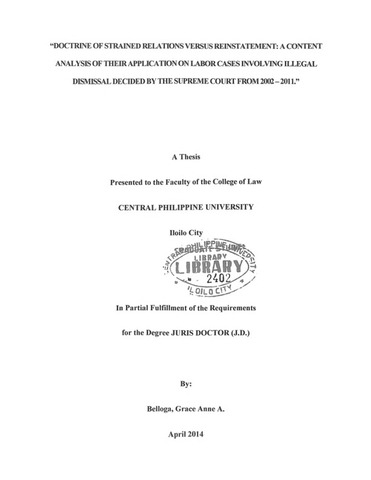Ipakita ang simpleng tala ng item
Doctrine of strained relations versus reinstatement: A content analysis of their application on labor cases involving illegal dismissal decided by the Supreme Court from 2002 -2011
| dc.contributor.adviser | Alibogha, Salex | |
| dc.contributor.author | Belloga, Grace Anne A. | |
| dc.date.accessioned | 2021-02-08T08:53:45Z | |
| dc.date.available | 2021-02-08T08:53:45Z | |
| dc.date.issued | 2014 | |
| dc.identifier.citation | Belloga, G. A. A. (2014). Doctrine of strained relations versus reinstatement: A content analysis of their application on labor cases involving illegal dismissal decided by the Supreme Court from 2002 -2011” (Unpublished postgraduate thesis). Central Philippine University, Jaro, Iloilo City. | en_US |
| dc.identifier.uri | https://hdl.handle.net/20.500.12852/228 | |
| dc.description | Abstract only | en_US |
| dc.description.abstract | This study aimed to conduct a content analysis on the doctrine of strained relations versus reinstatement on their application on labor cases Involving illegal dismissal decided by the Supreme Court from 2002 - 2011. The non-experimental longitudinal and the quantitative content analysis were used as research designs and in gathering the data for this study. The non-probability sampling technique was used in the population sampling of this study. The purposive samples were all labor cases which involved illegal dismissal and called for the application of the doctrine of strained relations or order of reinstatement decided by the Supreme Court of the Philippines for a period of ten (10) years from 2002 to 2011. There were 49 labor cases involving illegal dismissal decided by the Supreme Court used for this study. Findings showed that only 10 cases called for the application of the doctrine of strained relations, whereas there were 21 cases in which the reinstatement order was rendered by the Supreme Court. In 16 cases, the Supreme Court ruled in favor of the payment of the separation pay due to the lapse of time that passed from the time of termination until the finality of the case, unavailability of the previous position held, etc. In the subject cases of this study, the Supreme Court ordered the payment of separation due to strained relation in only nine (9) cases. Thus, the incidence of the application of the doctrine of strained relations was relatively lower compared to the grant of reinstatement. The Supreme Court granted the payment of other money claims in two labor cases. Results showed further, that most rank-and-file employees filed illegal dismissal cases against their employers due to the lack of just or authorized cause/s of termination. No specific class of employees which file illegal dismissal cases against their employers. There were also managerial and supervisory employees who filed illegal dismissal cases against their employers. Furthermore, most of the illegal dismissal cases were filed due to the absence of just or authorized cause in terminating the employee. | en_US |
| dc.format.extent | ii, 85 leaves | en_US |
| dc.language.iso | en | en_US |
| dc.subject.ddc | GSL Theses 340.72 B417 | en_US |
| dc.subject.lcsh | Labor laws and legislation | en_US |
| dc.title | Doctrine of strained relations versus reinstatement: A content analysis of their application on labor cases involving illegal dismissal decided by the Supreme Court from 2002 -2011 | en_US |
| dc.type | Thesis | en_US |
| dcterms.accessRights | Limited public access | en |
| dc.description.bibliographicalreferences | Includes bibliographical references | en_US |
| dc.contributor.department | College of Law | en_US |
| dc.description.degree | Juris Doctor | en_US |
| local.subject | Doctrine of strained relations | en_US |
| local.subject | Reinstatement | en_US |
| local.subject | Jurisprudence - Labor | en_US |
| local.subject | Illegal dismissal | en_US |
Mga file sa item na ito
Lumilitaw ang item na ito sa mga sumusunod na (mga) Koleksyon
-
Juris Doctor [144]


